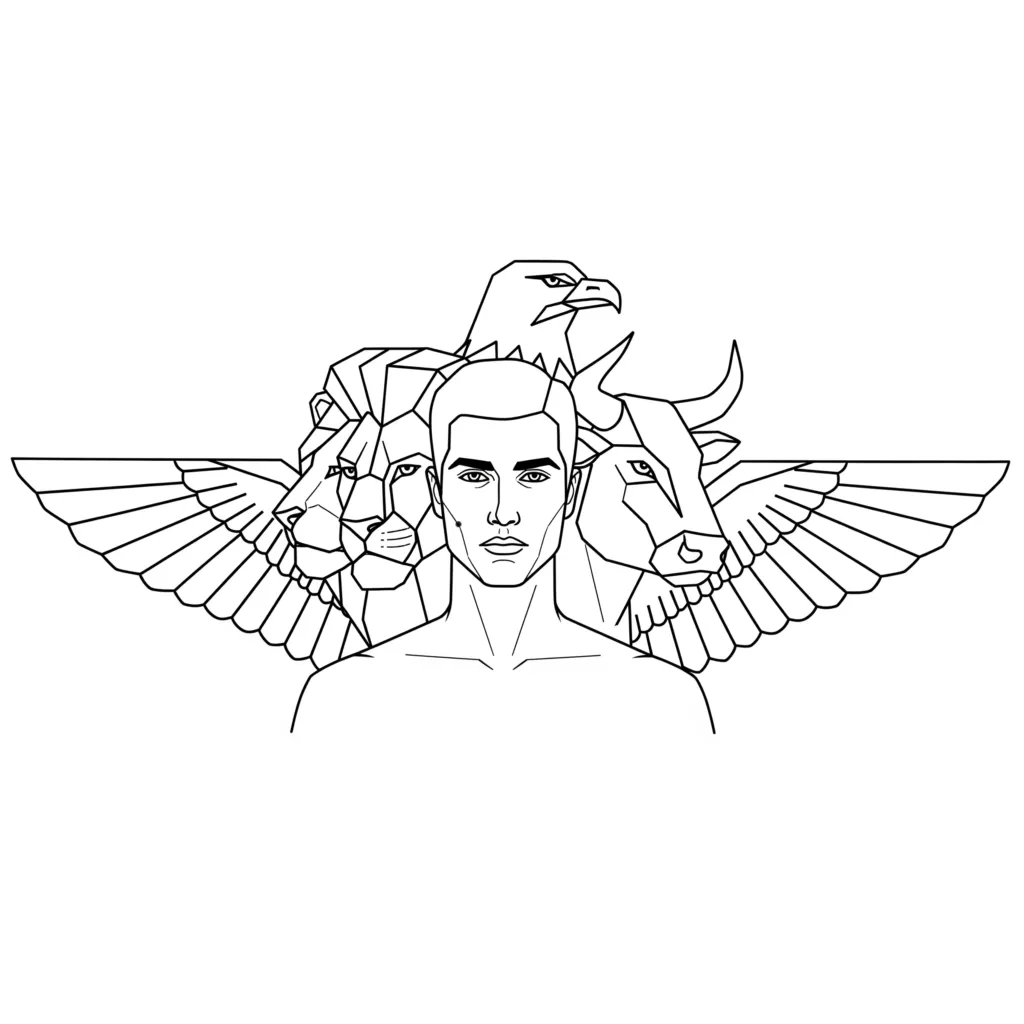
In Neville Goddard’s teaching, the Bible is not a history book but a guide. Its characters teach the Law of Assumption—living from the end. Each figure demonstrates how to assume a state and bring it into visible form.
Abraham, Jacob, Joseph, and Judah are the primary teachers of this law. Their stories reveal the steps of manifestation: Faith, Persistence, Imagination, and Praise. Aligned symbolically with the four Gospels and Ezekiel’s vision, they show how assumption becomes creation.
ABRAHAM: FAITH (Matthew)
Abraham demonstrates faith—the living conviction of the unseen. He leaves his homeland, family, and familiar life, moving into new states of being with trust in the promise. His story with Sarah, including the arrangement of a wife for Isaac, symbolises the principle of Genesis 2:24: leaving old states behind and joining with new ones. Through this, he shows how to follow inner guidance to manifest what the imagination conceives.
“The book of the genealogy of Jesus Christ, the son of David, the son of Abraham.”
— Matthew 1:1
Abraham shows that faith is the inner conviction of the end already fulfilled. Every step he takes—from leaving his homeland to arranging a wife for Isaac—manifests the principle of assuming the unseen as real. The outer world bends to imagination only when the inner state is fixed, sustained, and trusted.
JACOB: PERSISTENCE (Mark)
Jacob teaches persistence in assumption and the principle that “the seed is within itself.” His story of the grafted branches in the watering troughs shows how he learned to match conditions with imagination, striving to form a new identity. His struggles with Laban represent the challenges faced when holding onto a new inner state amid external opposition, and his bold act of presenting himself to Isaac in Esau’s guise illustrates the imaginative assumption of an identity as if it were already real.
“I will not let you go unless you bless me.” — Genesis 32:26
Jacob demonstrates that persistence is not a single act but a continual holding of the desired state until it manifests. By wrestling to form himself as a new man and negotiating life’s outer symbols, he models the patient application of the Law of Assumption, showing how inner vision shapes external circumstances.
JOSEPH: IMAGINATION (Luke)
Joseph teaches provision and disciplined imagination—the ability to hold an inner vision until it externalises. Even in times of betrayal, famine, slavery, and imprisonment, he imagines abundance and demonstrates provision in imagination, ultimately aligning all opposing aspects of the mind with his inner purpose. Luke’s Gospel reflects this same principle through miraculous births and angelic visions, proving that imagination shapes reality.
“For with God nothing will be impossible.” — Luke 1:37
Joseph shows that imagination is not idle dreaming but active creation. He embodies the principle that even in apparent lack, abundance can be assumed and made manifest through disciplined inner vision.
"He had sent a man ahead of them, Joseph, who was sold as a slave.
His feet were hurt with fetters; his neck was put in a collar of iron;
until what he had said came to pass, the word of the LORD tested him.
The king sent and released him;the ruler of the peoples set him free;
he made him lord of his house and ruler of all his possessions,
to bind his princes at his pleasure and to teach his elders wisdom." — Psalm 105:17-22
JUDAH | JUDAS: PRAISE (John)
Judah’s name means praise—assumption lifted up as “I AM.” He steps forward to protect Benjamin and becomes the ancestor of Christ, showing the conscious assumption of identity. John’s Gospel makes this explicit: “I AM the way, and the truth, and the life” (John 14:6), demonstrating the state already assumed, not sought.
John’s Beheading and Judas’s Betrayal:
John the Baptist’s beheading signals the end of preparation: the identity is assumed now. Judas’s betrayal is not failure but the mind releasing the I AM to be fixed in awareness, sealing the assumption until it rises as fact.
Male Figures as States of Being
In Scripture, "men" represent the imaginative perception of self, forming itself in the mind—created in the image of the creative principle. Abraham, Jacob, Joseph, and Judah are not just patriarchs but personifications of conscious postures. Their lives teach faith, persistence, imagination, and praise, guiding the practitioner in assuming new states and manifesting them into reality.
✦ Conclusion: The Gospels as Stages of Assumption
There are four Gospels in the New Testament—not because the life of Jesus required multiple accounts, but because each reveals a spiritual law in operation from a different angle, seeded from the stories of Abraham, Jacob, Joseph, and Judah. Together, they serve not only as biographies, but as studied and embodied foundational qualities that support the emergence of the Christ within man:
- Matthew (Abraham): Faith—assuming the unseen as true.
- Mark (Jacob): Persistence—holding the new state until it is secured, teaching the seed within itself.
- Luke (Joseph): Imagination—assuming abundance even in lack, shaping the unseen into the seen.
- John (Judah): Praise—the conscious raising of I AM into identity.
These stories are instruction in action. They show how assumption creates reality: faith to begin, persistence to endure, imagination to shape, and praise to embody. This is the Gospel in motion—the Law of Assumption demonstrated through the lives of its teachers.
The Four: Fathers Of The Law | Abraham Series | Jacob Series | Joseph Series | Judah Series
